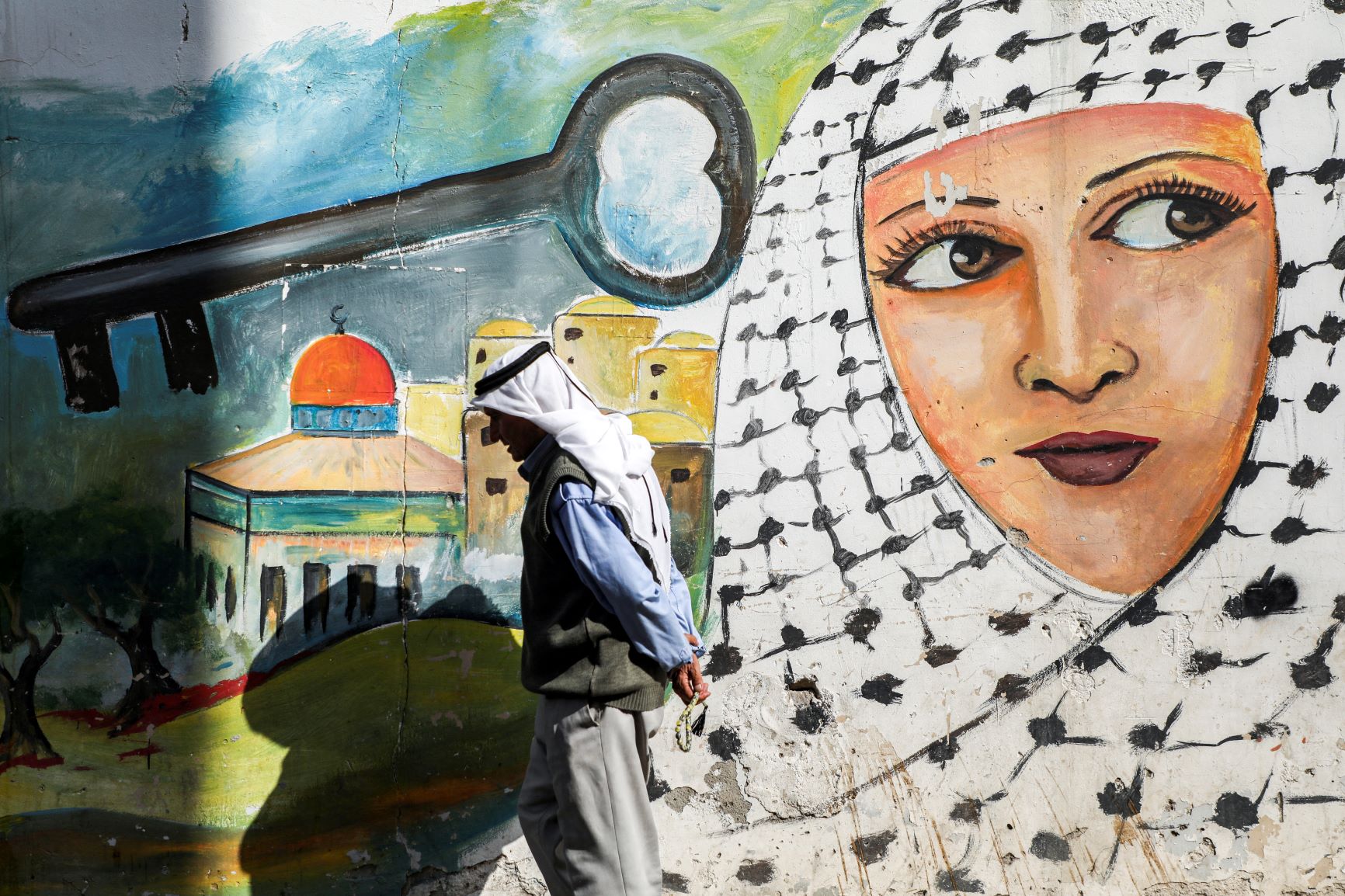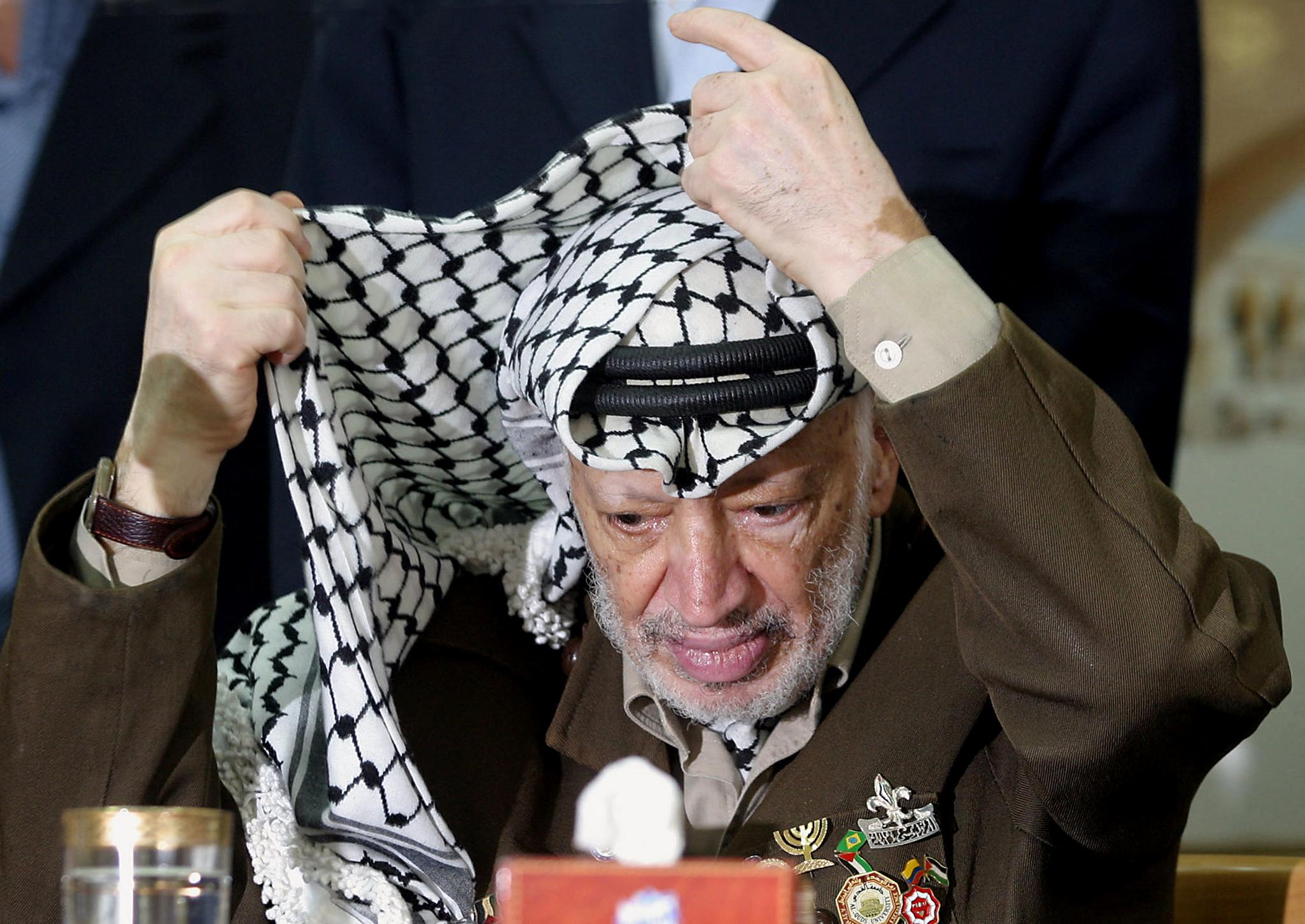A closer look at the origins of Palestine’s iconic headscarf and how it transcended borders

28 May 2021 13:53 UTC
A distinctly Palestinian black-and-white chequered piece of cloth, the keffiyeh is described by some as the nation’s unofficial flag.
Long synonymous with the Palestinian cause, the simple square-metre fabric, traditionally folded diagonally into a triangle and worn draped over the head of rural Palestinian men, is today securely fashioned around the necks of human rights activists, anti-war protesters, sports stars and celebrities; transcending gender, religion and nationality.
Muhammad Walid, 49, from Jerusalem says he remembers seeing his father and uncles wear the keffiyeh in his earliest memories.
“The older generations would wear it on their heads,” he says. “I started wearing it as a teenager, but around my neck. For me, it represents the Palestinian struggle and cause.”
It’s a similar story for Riad Halak, 62, also from Jerusalem, who says: “It’s a tradition of Palestine. I started wearing one when I was 11 years old, and I still wear it today on special days like the Nakba. It’s part of my identity.”
While the keffiyeh’s status as an icon of Palestinian nationhood is undisputed, its origins lie further east, in what is now Iraq.

The word itself means “relating to Kufa,” a reference to the Iraqi city south of Baghdad that sits along the Euphrates river, but little else is known about the roots of the keffiyeh. One account suggests it came about in the seventh century, during a battle between Arab and Persian forces near Kufa. The Arabs were said to have used cords made from camel hair to secure their headdresses and in order to recognise their comrades in the heat of battle. After their victory, the headgear was kept on as a reminder of their triumph.
Others say the fabric, sometimes called the hata in the Levant, has origins that pre-date Islam and can be traced back to Mesopotamia, when it was worn by Sumerian and Babylonian priests around 5,000 years ago.
“Its origins are open to speculation,” Anu Lingala, author of A Socio-political History of the Keffiyeh, tells Middle East Eye. “Until very recently, these types of designed objects were not taken seriously as subjects of academic research. The exception was for designed objects that were associated with elite status and wealth, whereas the keffiyeh was traditionally associated with working classes.”
Shorthand for the struggle
Although no longer linked to social status, the keffiyeh’s modern roots in Palestine are among the fellah, or rural workers, as well as the Bedouin. The two groups would wear the garment over their heads to cover the backs of their neck and protect themselves from the heat of the summer sun and the cold during the winter.
According to Lingala: “Covering one’s head was an important principle in traditional Palestinian culture.
Israel-Palestine: British media coverage ‘skewed’ and ‘biased’, report finds
“[The keffiyeh] afforded breathability through air pockets created by folds in the fabric,” she says.
The more educated, urban Palestinians, or effendi, would wear the fez or tarboush, a deep-red felt hat popularised by Ottoman ruler Mahmud II and adopted by locals as a standard form of dress.
Cultural historian Jane Tynan has written about the scarf’s significance in the book Fashion and Politics. She says: “The Ottoman Empire’s dress codes had the effect of erasing ethno-religious identities, but would have been worn as a norm by urban dwellers.”
After the Turkish empire’s loss of its Near Eastern territories during the First World War, and the Arab Revolt against British colonial rule in 1936, Palestinian nationalists also used the keffiyeh as a means of covering their faces to hide their identity and avoid arrest, spurring unsuccessful calls among the British to ban the headscarves. Instead, in a “pivotal moment in Palestinian culture,” Palestinians united in adopting the fabric as a sign of solidarity. The symbol remained a staple icon of Palestinian nationhood after the Nakba and the establishment of the state of Israel.
“Palestinians of all social classes abandoned the fez and united around wearing the keffiyeh, making it difficult to identify the revolutionaries,” Maha Saca, head of the Palestinian Heritage Centre in Bethlehem, tells Middle East Eye.
Tynan, an assistant professor in design history and theory at Vrije Universiteit Amsterdam, says that “from its function in the revolt as a tool to disguise the identity of the wearer from British authorities, the keffiyeh became shorthand for the Palestinian struggle”.

Lingala makes a similar point: “As Palestinians’ collective identity and right to the land continued to be increasingly threatened… they sought to hold onto items that represented ‘cultural continuity’.”
Years later, in the 1960s, the late Palestinian leader Yasser Arafat popularised the garment among a global audience. According to Saca: “Abu Ammar [Arafat] would never be seen at any event without it.”
His keffiyeh was always carefully positioned on his head, with the longer end of the fabric placed over his right shoulder – some say it was laid out to resemble a map of pre-1948 Palestine.

When Israeli occupation authorities banned the Palestinian flag from 1967 until the Oslo Accords in 1993, the scarf took on a potent symbolism, according to Ted Swedenburg, professor of anthropology at Arkansas University.
“Portable and visible symbols” were important to Palestinians, Swedenburg says, adding that with the flag banned by the occupation for alomost 30 years, the keffiyeh, “to which so much rich symbolism and history was attached, served as an everyday, portable, visual expression of Palestinian identity”.
Wheat, olives and honey
The distinct black stitching on the white cotton keffiyeh is said to have many symbolic meanings, and although none have been verified, Palestinians have no shortage of interpretations.
It has been described by some as “a fishing net, a honeycomb, the joining of hands, or the marks of dirt and sweat wiped off a worker’s brow”. Others suggest the design represents ears of wheat, in reference to Jericho, one of the first known cities to cultivate the grain.
Palestinian performance artist Fargo Tbakhi adds “barbed wire” to the list, explaining the pattern could depict “that ever-present symbol of the occupation,” although he relates most to the fishing net design, also called the fatha (opening).
“[I see it] as a symbol of our identity, a model for being Palestinian, it articulates one possible futurity for our people,” he writes in the Los Angeles Review of Books.
“A fishnet is an image of collectivism, of entanglement and dependence: in a net, singular strands become something larger, stronger. As one strand, I am always yearning to be knotted together with others, so that we are better able to hold, to catch.”
Palestinian author Susan Abulhawa tells Middle East Eye that the patterns on the keffiyeh “speak to Palestinian lifeblood, in the same way that the patterns of tatreez [Palestinian embroidery] is a language unto itself, telling stories of location, lineage, occasion, and historic significance”.
The black stitching is sometimes also referred to as a honeycomb design, in recognition of the region’s beekeepers; some rural Syrians (where the cloth is also worn) say the pattern symbolises the joining of hands and the marks of dirt and sweat wiped off a worker’s brow.
A recent tweet included another interpretation of the design, a representation of Palestine’s olive trees, which show “strength and resilience”:
Share this post to educate people on our traditional Kuffieyeh
pic.twitter.com/R3jvs0DWp1— mars | FREE PALESTINE (@peachesfrompali) May 17, 2021
Abulhawa agrees: “The ‘bird-like’ motifs along the border are interconnected olive leaves, referring to the significance of the olive tree in Palestinian life.”
Olives, in all forms – olive oil, olive-oil products (such as soap), and olive wood – were hugely important aspects of Palestinian culinary, social and economic life, Abulhawa explains.













No comments:
Post a Comment